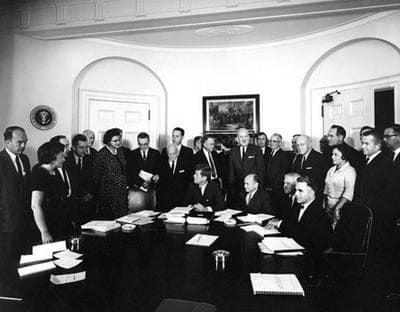Advertisement
Kennedy's Other Civil Rights Legacy
You won’t recognize her name but Shelia McGrath of Colorado is as central to President John F. Kennedy’s civil rights legacy as James Meredith of Mississippi.
Kennedy’s efforts on her behalf were less dramatic, but no less historic, than his decision to order federal troops to the University of Mississippi to protect Meredith, the first black man to enroll in classes on that defiantly segregationist campus in 1962.
In this era of atom-splitting and wonder drugs and technological advance, it is still widely assumed — even among some medical people — that the future for the mentally retarded is hopeless.
Eunice Kennedy Shriver, 1962
The year before, the new president had welcomed Shelia McGrath, a 7-year-old towhead with profound intellectual disabilities, and her family to the White House, the first American president to put what we then called mental retardation on the national agenda. The National Association for Retarded Children pictured Shelia and her 5-year-old sister, Kammy, on millions of posters in 1961 to highlight the need for more research into the causes and treatment of mental retardation. Kammy was born with the same inherited metabolic disorder that had caused Shelia’s disabilities but a new diagnostic test and reparative diet had spared her the same fate.
It was the president’s sister, Eunice Kennedy Shriver, who orchestrated the McGraths’ White House visit on November 14, 1961 and his sister who convinced Kennedy to assemble the most prominent scientists of the time as the President’s Panel on Mental Retardation to advise him how the federal government could reduce the incidence of the debilitating condition that afflicted their own sister, Rosemary.
The subject of intellectual disabilities was then so socially and emotionally fraught that it would be another year before the Kennedys would publicly disclose Rosemary’s condition in a September 22, 1962 article for The Saturday Evening Post that appeared under Shriver’s byline. “We are just coming out of the dark ages in our handling of this serious national problem,” the article read. “Even within the last several years, there have been known instances where families have committed retarded infants to institutions before they were a month old and ran obituaries in the local papers to spread the belief that they were dead. In this era of atom-splitting and wonder drugs and technological advance, it is still widely assumed — even among some medical people — that the future for the mentally retarded is hopeless.”

Shriver’s conviction that those assumptions were wrong produced more than Oval Office photo ops and White House study groups. Although her brother had shown no particular interest in the subject during his tenure representing Massachusetts in the U.S. House and Senate, Kennedy — at Shriver’s urging — met with the presidential panel and installed an unprecedented special assistant in the White House whose sole responsibility was to advance the needs of those with intellectual disabilities.
Only a few weeks before his assassination in Dallas, Kennedy acted on the recommendations of that panel, signing two major pieces of legislation that would forever alter the national landscape for the intellectually disabled. One, an amendment to the Social Security Act, expanded maternal and child health programs within the National Institute of Health to prevent and combat mental retardation. The other, the Mental Retardation and Community Mental Health Centers Construction Act of 1963, provided federal funding for community centers and research facilities and created a Division of Handicapped Children and Youth in the Department of Education to fund the training of special needs teachers and to promote educational opportunities for mentally disabled children.
In the years since, Congress has enacted dozens of laws to support people with intellectual disabilities and their families, including the landmark Americans With Disabilities Act of 1990. But those first Kennedy Administration initiatives represented a seismic policy and cultural shift.
Only a few weeks before his assassination, [the president signed] two major pieces of legislation that would forever alter the national landscape for the intellectually disabled.
Like Shelia McGrath and Rosemary Kennedy, most people with intellectual disabilities in 1963 lived in institutions, far from their families. Perhaps the president was thinking of Shelia and Rosemary at the bill signing ceremony in the White House Cabinet Room on October 31, 1963, just three weeks before his death.
“It was said in an earlier age that the mind of a man is a far country, which can never be approached or explored. But today, under our present condition of scientific achievement, it will be possible for a nation as rich in human and material resources as ours to make the remote reaches of the mind accessible,” John F. Kennedy said. “The mentally ill and the mentally retarded need no longer be alien to our affections or beyond the help of our communities.”
This program aired on November 22, 2013. The audio for this program is not available.
